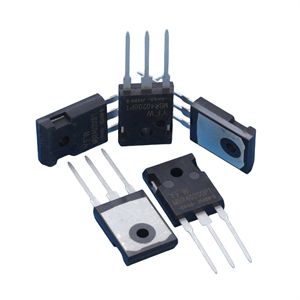Date:2024-11-14 Categories:Product knowledge Hits:528 From:Guangdong Youfeng Microelectronics Co., Ltd
Controllable silicon and IGBT are two commonly used power semiconductor devices in the field of modern power electronics. Although both can play important roles in power control and conversion, they have significant differences in structure, working principle, performance characteristics, and applications.
This article will provide a detailed introduction to the differences between thyristors and IGBTs.
1、 Structural differences
Controllable silicon is a multi-layer PN junction device composed of NPNPN structure, which usually consists of four electrodes, namely gate (G), anode (A), cathode (K), and spiral coil (C); IGBT is a three terminal device composed of MOSFET and bipolar transistor (BJT), typically consisting of three electrodes: gate (G), collector (C), and emitter (E).
2、 Differences in working principles
1. Working principle of thyristor
Controllable silicon generally operates between conducting and off states, and its control is mainly achieved by the current pulse at the control terminal. When a trigger pulse is applied to the control terminal, the thyristor will transition from the off state to the on state, and when the current at the control terminal is less than the holding current, the thyristor will automatically return to the off state.
2. Working principle of IGBT
The working principle of IGBT involves the combined action of MOSFET and BJT. When a positive voltage is applied to the gate, the channel of the MOSFET forms a conductive channel, causing current to flow between the collector and emitter. The function of BJT is to enhance the conductivity of MOSFET and improve the power processing capability of the entire device.
3、 Differences in performance characteristics
1. Differences in frequency characteristics
The frequency characteristics of thyristors are relatively low, with operating frequencies typically below 20kHz, while IGBTs have higher operating frequencies, reaching several hundred kHz or even higher. Due to its high frequency characteristics, IGBT is suitable for high-frequency power electronics applications such as inverters, AC motor drivers, etc.
2. Difference in switch speed
The switching speed of thyristors is relatively slow, usually between a few microseconds and tens of microseconds, while the switching speed of IGBTs is relatively fast, usually between tens of nanoseconds and a few microseconds. Due to its fast switching speed, IGBT is suitable for applications that require high conversion efficiency and fast response.
3. Differential voltage drop during conduction
Controllable silicon has a large conduction voltage drop, usually above 1V, while IGBT has a smaller conduction voltage drop, usually below 1V. Due to its smaller conduction voltage drop, IGBT can provide higher conversion efficiency and lower power consumption.
4、 Application differences
1. Application of thyristor
Controllable silicon is mainly used in fields such as AC power supply, lighting dimming, temperature control, and AC motor control. Due to its large conduction voltage drop and low switching speed, thyristors are suitable for applications that require lower frequencies and higher power.
2. Application of IGBT
IGBT is mainly used in fields such as inverters, AC motor drivers, and power modulators. Due to its small conduction voltage drop and fast switching speed, IGBT is suitable for applications that require high frequency and high conversion efficiency.
In summary, there are significant differences between thyristors and IGBTs in terms of structure, working principle, performance characteristics, and applications. Controllable silicon is suitable for low-frequency high-power applications, while IGBT is suitable for high-frequency and high-efficiency applications. In practical applications, it is crucial to choose suitable devices based on specific needs and requirements.

Previous: Classification, Structure, and Principle of MOSFET
Next: Using voltage inspection method to quickly locate fault points in integrated circuits